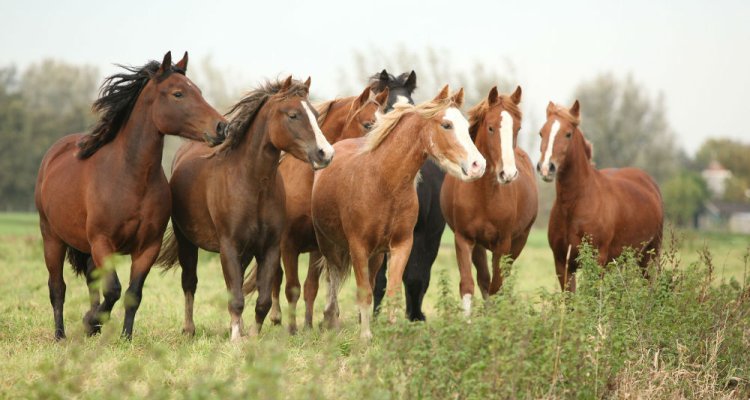
Equine infectious anaemia
Equine infectious anaemia (EIA) is a viral infectious disease that causes anaemia and is associated with recurrent periods of fever.
Equine infectious anaemia occurs in horses, mules and donkeys, and is transmitted by bloodsucking insects. The foetus can also become infected in pregnant animals. The equine infectious anaemia virus (EIAV) is a lentivirus and belongs to the same family as the maedi-visna virus in sheep and HIV (cause of the disease AIDS) in humans. Once a horse has become infected, the animal may remain infectious for other horses for life. Humans cannot be infected with the EIA virus (EIAV).
Equine infectious anaemia is a notifiable animal disease. If the disease is suspected, the NVWA must be informed. It is often difficult to distinguish EIA from other diseases associated with fever. It can only be done through laboratory testing.
Clinical signs equine infectious anaemia
There are various stages in EIA. Horses may survive the infection without evident clinical symptoms, an acute phase may be observed, or the disease may have a chronic progression. The incubation period, before clinical symptoms can be observed, is 3-30 days, but may also be much longer. All animals infected with the EIA virus remain carriers for life and form a potential source of infection.
Acute
The disease often starts with acute symptoms that are potentially, but not often, fatal. In this acute phase, making a diagnosis is difficult, because the symptoms appear rapidly, and often only an elevated body temperature is found. Apart from fever, however, lethargy, anaemia, bleeding and reduced appetite may also be observed. During this phase of the disease, the blood contains extremely high concentrations of the virus, and the risk of transmission is relatively high.
Chronic
If the animal does not die during the acute phase of the disease, it may become chronic. The horse will then have periods of fever (with intervening periods lasting weeks or even years), anaemia, weight loss and fluid retention (oedema) under the belly and on the legs.
Diagnostics equine infectious anaemia
Vaccine equine infectious anaemia
Prevention and control of equine infectious anaemia
Transmission of EIA usually occurs through the transfer of infected blood by blood-sucking insects, infected blood plasma, needles, syringes or other materials contaminated with blood.
Transmission of EIA by blood-sucking insects depends on the density of the horse population, the number of EIA-infected animals and the number, and behaviour of the insects (fly, horsefly and other large blood-sucking insects). The virus does not propagate in the insect, which transmits the virus only via the proboscis.
Transplacental infection can also occur (vertical transmission during the pregnancy of the infected horse to the foal) or when an infected stallion covers a mare.
The reuse of contaminated syringes and needles is a significant factor in transmitting EIA.
Limiting further transmission
In order to counter (further) transmission of EIAV, transmission via infected horses must in the first instance be minimised or ruled out.
Horses infected with EIA carry the virus for the rest of their lives. This results from the fact that the virus inserts its DNA into certain types of cell. If the animals find themselves under stress and/or are treated with corticosteroids, the virus may multiply again and make the animal ill. The animal is thus a constant "danger" to itself and to the horses around it.
As the Netherlands is free of this disease, it is important that non-infected horses are protected by placing an infected horse in quarantine (at a distance of at least 200 m from other horses) or by euthanising it.
Until every horse has been tested at a location, the assumption is that every horse at the location, or that has been there, is a potential EIAV reservoir. The NVWA will close off the location and let WBVR test all the other horses over a period of three months to check that they have not become infected.
Precautions for horse owners
The owners of horses can reduce the risk of infection with and spread of EIAV by taking a number of steps.
- Use disposable syringes and needles. Follow the rule: a separate needle for each horse. Vets in the Netherlands always use disposable needles. They will also use blood products from donors that have been tested for EIA.
- Clean and sterilise all instruments that could be contaminated with blood after each use.
- Keep separate all horses, mules and donkeys newly imported from abroad until they have been tested for EIA, or insist that a recent negative EIA test certificate is shown on import.
- There is risk of transmission by insects, if an infected horse is present less than 200 metres away from the operation/farm. At a distance greater than 200 metres, the risk of infection via this route is small.
- Contact the vet as soon as clinical symptoms are observed that could indicate infection with EIAV.